High Impact Tutoring Built By Math Experts
Personalized standards-aligned one-on-one math tutoring for schools and districts
In order to access this I need to be confident with:
Addition and subtraction Multiplication Fractions Numerator and denominator Improper fraction to mixed number Multiplying fractions Decimals Powers of 10Division
Here you will learn about division, including dividing into equal groups, long division, dividing decimals, and dividing fractions.
Students will first learn about division as part of operations and algebraic thinking in 3 rd grade.
What is division?
Division is the process of splitting a number into equal parts or a group of objects into smaller, equal groups. Division is one of the four basic operations (arithmetic operations) and it is the inverse or opposite of multiplication.
To write a division equation, you write the number being divided, the dividend, then a division sign, and then the number that the dividend is being divided by, which is called the divisor. The answer to a division equation is called the quotient.
For example,
Annie wants to split her 28 marbles into equal groups of 4. How many marbles will be in each group?
You would write this as
28 \div 4= {?}To solve, you need to divide 28 into 4 equal groups.

There are 7 in each group, so 28 \div 4=7
You can also solve division facts by writing the equation as an unknown factor problem.
For example, you can solve 28 \div 4 by finding the number that makes 28 when multiplied by 4.
\begin{aligned}& 4 \times{?}=28 \\\\ & 4 \times 7=28 \end{aligned}![[FREE] Multiplication and Division Worksheet (Grade 4, 5 and 7)](https://thirdspacelearning.com/wp-content/uploads/2023/11/Multiplication-and-Division-Check-for-Understanding-listing-image.png)
[FREE] Multiplication and Division Worksheet (Grade 4, 5 and 7)
![[FREE] Multiplication and Division Worksheet (Grade 4, 5 and 7)](https://thirdspacelearning.com/wp-content/uploads/2023/11/Multiplication-and-Division-Check-for-Understanding-listing-image.png)
Use this quiz to check your grade 4, 5 and 7 students’ understanding of multiplication and division. 10+ questions with answers covering a range of 4th, 5th and 7th grade multiplication and division topics to identify areas of strength and support!
DOWNLOAD FREE![[FREE] Multiplication and Division Worksheet (Grade 4, 5 and 7)](https://thirdspacelearning.com/wp-content/uploads/2023/11/Multiplication-and-Division-Check-for-Understanding-listing-image.png)
[FREE] Multiplication and Division Worksheet (Grade 4, 5 and 7)
![[FREE] Multiplication and Division Worksheet (Grade 4, 5 and 7)](https://thirdspacelearning.com/wp-content/uploads/2023/11/Multiplication-and-Division-Check-for-Understanding-listing-image.png)
Use this quiz to check your grade 4, 5 and 7 students’ understanding of multiplication and division. 10+ questions with answers covering a range of 4th, 5th and 7th grade multiplication and division topics to identify areas of strength and support!
DOWNLOAD FREELong division
To divide larger numbers, you can use the standard algorithm for division, or long division.
Long division is a method of dividing a multi-digit number by another number by repeatedly subtracting multiples of the divisor from the dividend, determining the quotient digit by digit, and bringing down additional digits until the division is complete.
For example,
2,592 \div 12={?}
The quotient is shown at the top. There is no remainder, so
2,592 \div 12=216If a division problem ends in a remainder, the reminder can be written next to the quotient at the top. For example, if there was a remainder of 2, this could be written as R 2. Remainders can also be written as fractions or decimals.
Dividing fractions
To divide fractions, multiply the dividend (the first number in the equation) by the reciprocal of the divisor (second number in the equation). To find the reciprocal of a fraction, switch the numerator and denominator.
Note that a whole number written as a fraction would be the number over 1, so its reciprocal would be 1 over the number. Example: 5=\frac{5}{1} so its reciprocal is \frac{1}{5}.
To remember this process of dividing, think “Keep Change Flip.”
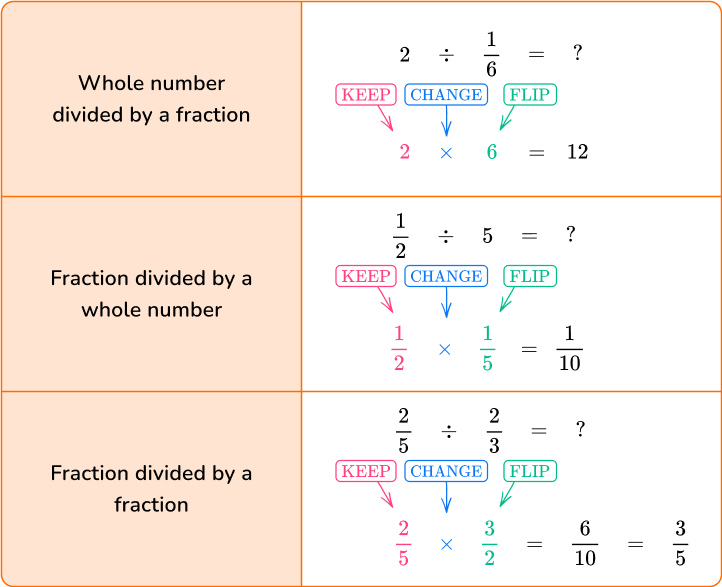
Dividing decimals
You can divide decimals using the standard algorithm, or long division. However, the divisor must be a whole number before you can start the long division process.
If the divisor is a decimal, you must multiply it by a power of 10 to shift the digits so there is no longer a decimal point. Whatever you multiply the divisor by, you must also multiply the dividend by.
For example,
a) 8.6 \div 2={?}
Since the divisor is a whole number, you can perform long division. Notice that the decimal point moves straight up to the same place in the quotient.
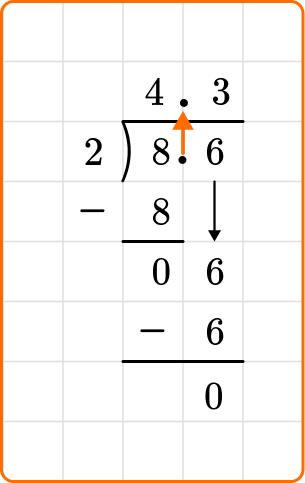
So, 8.6 \div 2=4.3
b) 24.66 \div 1.8={?}
In this example, the divisor, 1.8, is a decimal. Before you can begin the long division process, you will need to multiply 1.8 by a power of 10 so that it will be a whole number. Then you will need to multiply the dividend by that same power of 10.
To make 1.8 a whole number, you can multiply it by 10. Then you also multiply 24.66 by 10. So now, you would use long division to solve 246.6 \div 18.
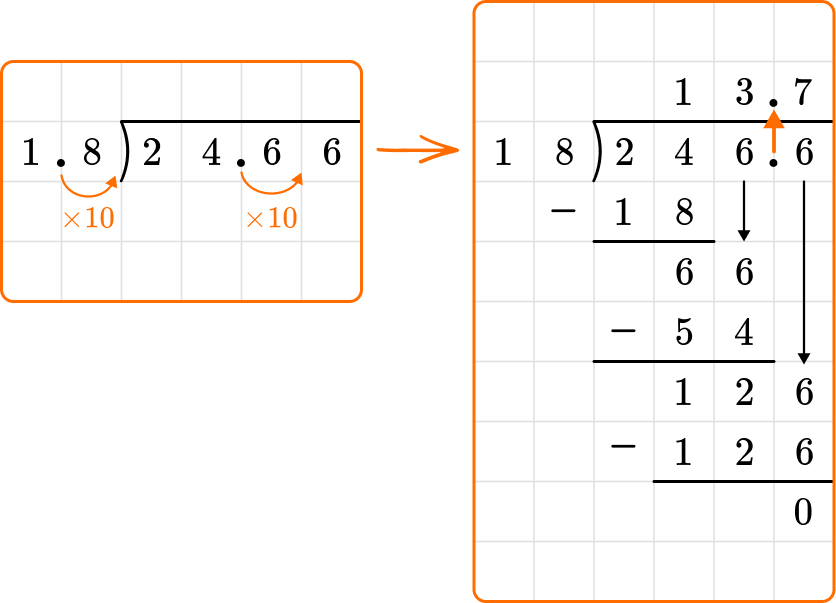
What is division?
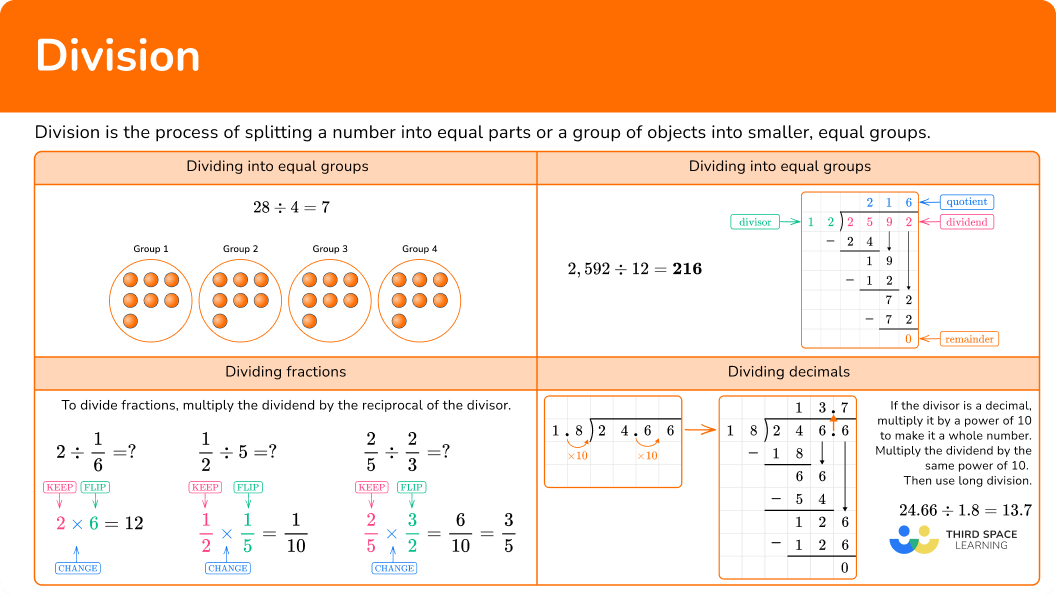
Common Core State Standards
How does this relate to 3 rd grade through 6 th grade math?
- 3rd Grade – Operations and Algebraic Thinking (3.OA.A.2)
Interpret whole-number quotients of whole numbers, e.g., interpret 56 \div 8 as the number of objects in each share when 56 objects are partitioned equally into 8 shares, or as a number of shares when 56 objects are partitioned into equal shares of 8 objects each.
For example, describe a context in which a number of shares or a number of groups can be expressed as 56 \div 8.
- 3rd Grade – Operations and Algebraic Thinking (3.OA.B.6)
Understand division as an unknown-factor problem. For example, find 32 \div 8 by finding the number that makes 32 when multiplied by 8.
- 4th Grade – Number and Operations in Base Ten (4.NBT.B.6)
Find whole-number quotients and remainders with up to four-digit dividends and one-digit divisors, using strategies based on place value, the properties of operations, and/or the relationship between multiplication and division. Illustrate and explain the calculation by using equations, rectangular arrays, and/or area models.
- 5th Grade – Number and Operations in Base Ten (5.NBT.B.6)
Find whole-number quotients of whole numbers with up to four-digit dividends and two-digit divisors, using strategies based on place value, the properties of operations, and/or the relationship between multiplication and division. Illustrate and explain the calculation by using equations, rectangular arrays, and/or area models.
- 5th Grade – Number and Operations in Base Ten (5.NBT.B.7)
Add, subtract, multiply, and divide decimals to hundredths, using concrete models or drawings and strategies based on place value, properties of operations, and/or the relationship between addition and subtraction; relate the strategy to a written method and explain the reasoning used.
- 5th Grade – Number and Operations—Fractions (5.NF.B.7, 5.NF.B.7a, 5.NF.B.7b, 5.NF.B.7c)
Apply and extend previous understandings of division to divide unit fractions by whole numbers and whole numbers by unit fractions.
Interpret division of a unit fraction by a non-zero whole number, and compute such quotients. For example, create a story context for (\cfrac{1}{3}) \div 4, and use a visual fraction model to show the quotient. Use the relationship between multiplication and division to explain that (\cfrac{1}{3}) \div 4 = \cfrac{1}{12} because (\cfrac{1}{12}) × 4 = \cfrac{1}{3}.
Interpret division of a whole number by a unit fraction, and compute such quotients. For example, create a story context for 4 \div (\cfrac{1}{5}), and use a visual fraction model to show the quotient. Use the relationship between multiplication and division to explain that 4 \div (\cfrac{1}{5}) = 20 because 20 \times (\cfrac{1}{5}) = 4
Solve real world problems involving division of unit fractions by non-zero whole numbers and division of whole numbers by unit fractions, e.g., by using visual fraction models and equations to represent the problem. For example, how much chocolate will each person get if 3 people share \cfrac{1}{2} lb of chocolate equally? How many \cfrac{1}{3} -cup servings are in 2 cups of raisins?
- 6th Grade – Number and Operations—Fractions (6.NS.A.1)
Interpret and compute quotients of fractions, and solve word problems involving division of fractions by fractions, e.g., by using visual fraction models and equations to represent the problem.
For example, create a story context for (\cfrac{2}{3}) \div (\cfrac{3}{4}) and use a visual fraction model to show the quotient; use the relationship between multiplication and division to explain that (\cfrac{2}{3}) \div (\cfrac{3}{4}) = \cfrac{8}{9} because \cfrac{3}{4} of \cfrac{8}{9} is \cfrac{2}{3}. (In general, (\cfrac{a}{b}) \div (\cfrac{c}{d}) = \cfrac{ad}{bc}.)
How much chocolate will each person get if 3 people share \cfrac{1}{2} lb of chocolate equally? How many \cfrac{3}{4} -cup servings are in \cfrac{2}{3} of a cup of yogurt? How wide is a rectangular strip of land with length \cfrac{3}{4} mi and area \cfrac{1}{2} square mi?
- 6th Grade – Number and Operations—Fractions (6.NS.B.2)
Fluently divide multi-digit numbers using the standard algorithm.
- 6th Grade – Number and Operations—Fractions (6.NS.B.3)
Fluently add, subtract, multiply, and divide multi-digit decimals using the standard algorithm for each operation.
How to divide
In order to divide objects into equal groups:
- Identify the total number of objects.
- Determine the number of groups.
- Divide the objects into equal groups.
In order to divide using long division:
- Set up the problem.
- Divide, multiply and subtract.
- Repeat step \bf{2} until the remainder is \bf{0}, or smaller than the divisor and finish to find the quotient.
In order to divide decimals:
- If the divisor is a whole number, go to step \bf{3}. If not, decide the power of ten that will make the divisor a whole number.
- Multiply both the divisor and the dividend by the same power of \bf{10} .
- If the dividend is a decimal number, line up the decimal point of the dividend with the decimal point of the quotient. You may need to include zeros as place holders.
- Perform long division.
In order to divide fractions:
- Take the reciprocal (flip) of the divisor (second fraction).
- Change the division sign to a multiplication sign.
- Multiply the fractions together.
- If possible, simplify or convert to a mixed number.
Division examples
Example 1: divide objects into equal groups
Marcus has 45 pieces of candy. He wants to divide his candy equally between himself and his 8 friends. How many pieces of candy will each person get?
- Identify the total number of objects.
Marcus has a total of 45 pieces of candy.
2Determine the number of groups.
Marcus is going to divide his candy between himself and 8 friends, so the candy will be divided into 9 equal groups.
3Divide the objects into equal groups.
45 \div 9=5 in each group
So each person gets 5 pieces of candy.
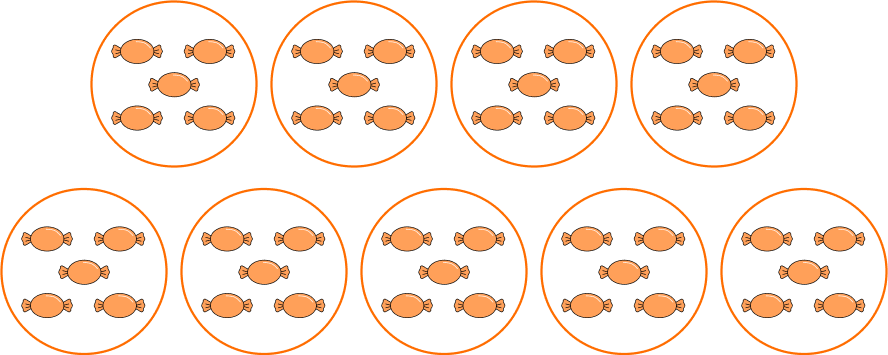
Example 2: long division (no remainder)
Solve 3211 \div 13 using long division.
Set up the problem.
When using long division, the numbers are set up under a symbol that is commonly referred to as a “bus stop” or a “house.”
The divisor goes outside of the “house” on the left, and the dividend goes inside the “house.” The quotient will go on top.
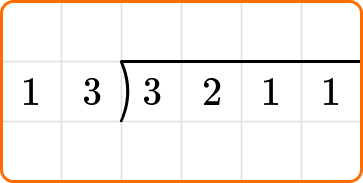
Divide, multiply and subtract.
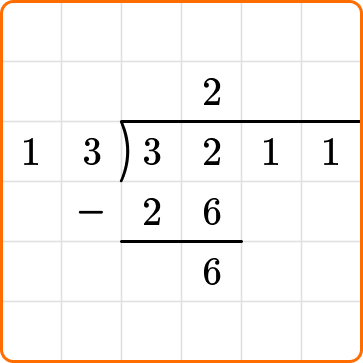
Repeat step \bf{2} until the remainder is \bf{0}, or smaller than the divisor and finish to find the quotient.
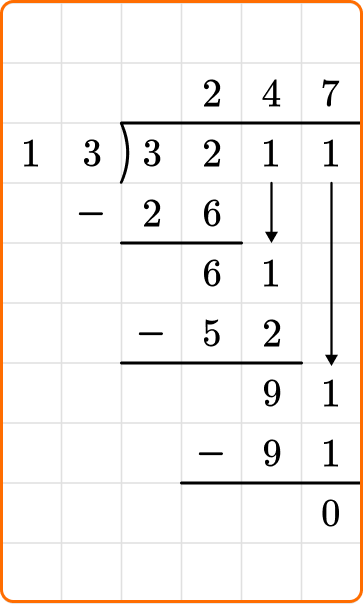
The remainder is zero, so the long division process is done.
That means 3,211 \div 13=247.
Example 3: long division (with remainder)
Solve 857 \div 5 using long division. Write the remainder as a fraction.
Set up the problem.
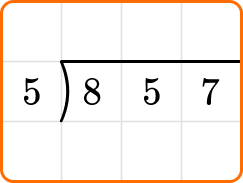
Divide, multiply and subtract.
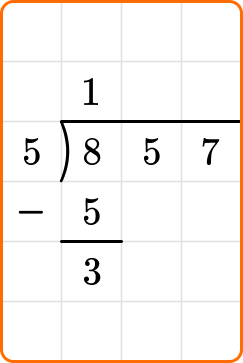
Repeat step \bf{2} until the remainder is \bf{0}, or smaller than the divisor and finish to find the quotient.
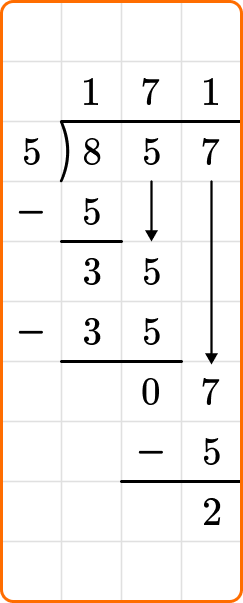
There is a remainder of 2. The directions state to write the remainder as a fraction. To do this, you write the remainder as the numerator and the divisor as the denominator.
So the quotient is 171 \cfrac{2}{5}.
Example 4: dividing decimals (whole number divisor)
Solve 71.4 \div 12 using long division.
If the divisor is a whole number, go to step \bf{3}. If not, decide the power of ten that will make the divisor a whole number.
In this division equation, the divisor, 12, is a whole number, so you can skip to step 3.
If the dividend is a decimal number, line up the decimal point of the dividend with the decimal point of the quotient. You may need to include zeros as place holders.
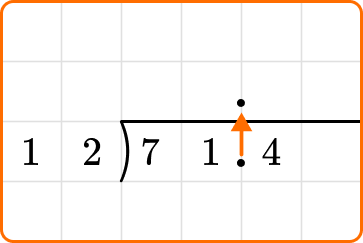
Do long division.
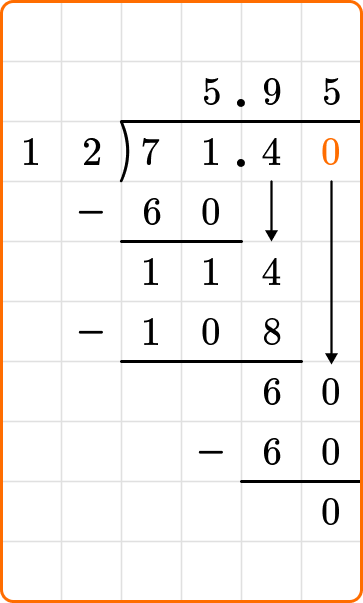
Notice that when getting a remainder when dividing decimals, you add a zero to the end of the dividend to bring down, then continue dividing.
Example 5: dividing decimals (decimal divisor)
Solve 5.13 \div 1.35 using long division.
If the divisor is a whole number, go to step \bf{3}. If not, decide the power of ten that will make the divisor a whole number.
The divisor, 1.35, is a decimal, so you need to multiply it by a power of 10 to make it a whole number.
To make 1.35 a whole number, you can multiply it by 10^2 or 100. You will also need to multiply the dividend by the same number.
Multiply both the divisor and the dividend by the same power of \bf{10} .
So the new division equation will be 513 \div 135.
If the dividend is a decimal number, line up the decimal point of the dividend with the decimal point of the quotient. You may need to include zeros as place holders.
Since the dividend and divisor are now whole numbers, there is no decimal point in the dividend to bring up to the quotient. There will only be a decimal point in the quotient if there is a remainder.
Do long division.
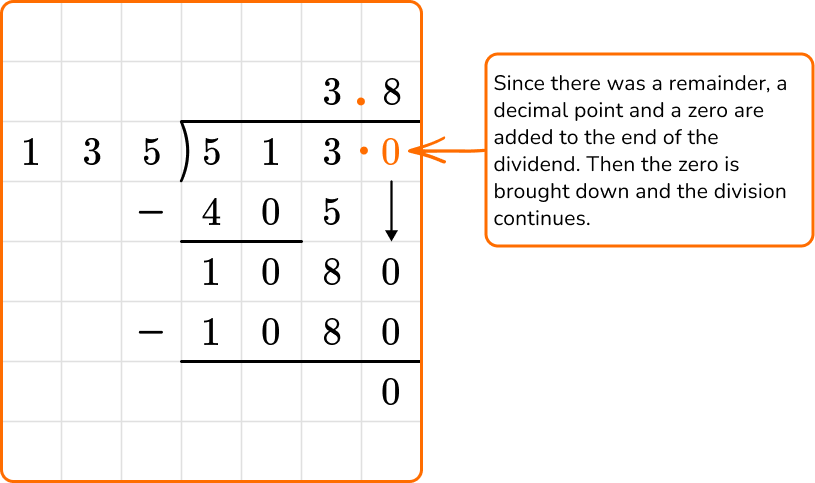
So, 5.13 \div 1.35=3.8
Example 6: whole number divided by a fraction
Solve 6 \div \cfrac{2}{3}
Take the reciprocal (flip) of the divisor (second fraction).
Change the division sign to a multiplication sign.
Multiply the fractions together.
Note that a whole number written as a fraction is the number as the numerator and 1 as the denominator. So the number 6 as a fraction is \cfrac{6}{1}.
\cfrac{6}{1} \times \cfrac{3}{2}=\cfrac{18}{2}
If possible, simplify or convert to a mixed number.
Example 7: fraction divided by a whole number
Solve \cfrac{4}{5} \div 3 .
Take the reciprocal (flip) of the divisor (second fraction).
Change the division sign to a multiplication sign.
Multiply the fractions together.
If possible, simplify or convert to a mixed number.
The fraction is in its simplest form, so the quotient is \cfrac{4}{15}.
Example 8: fraction divided by a fraction
Solve \cfrac{3}{4} \div \cfrac{1}{2}
Take the reciprocal (flip) of the divisor (second fraction).
Change the division sign to a multiplication sign.
Multiply the fractions together.
If possible, simplify or convert to a mixed number.
Teaching tips for division
- Review divisibility rules to assist students with long division. Divisibility rules help with long division by allowing students to more quickly identify potential divisors, reducing the number of attempts needed to find the correct one. For example, “A number is divisible by 2 if it ends in 0, 2, 4, 6, or 8. “
- Teach students different strategies for solving division problems, such as repeated subtraction, equal groups, or using multiplication facts. Encourage them to choose the strategy that works best for them.
- Offer plenty of opportunities for students to practice division through hands-on activities and games, not just worksheets.
- Knowing multiplication tables can help students divide, so provide practice for fluency as needed.
Easy mistakes to make
- Forgetting place value
Students may forget to align digits correctly when performing long division, leading to errors in the quotient.
- Forgetting to check for remainders
Students may forget to check for remainders or may incorrectly interpret them.
Related multiplication and division lessons
Practice division questions
1. Johnny has 30 marbles. He divided them evenly between 6 jars. How many marbles are in each jar? Which model represents this problem?
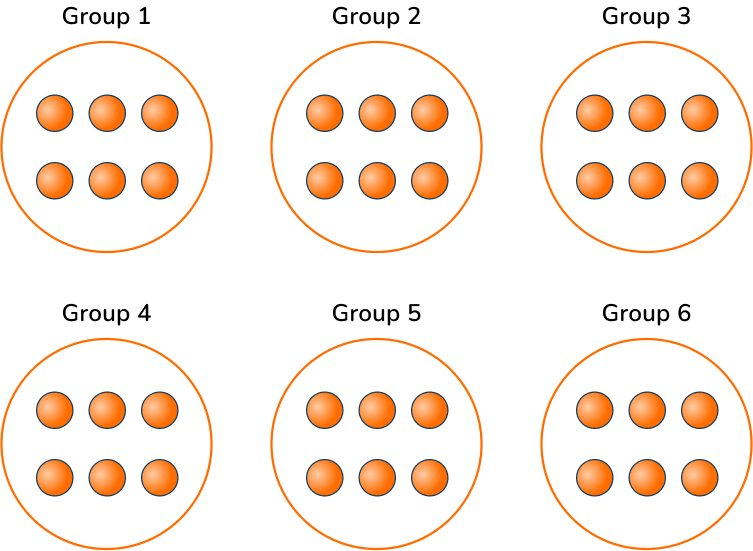

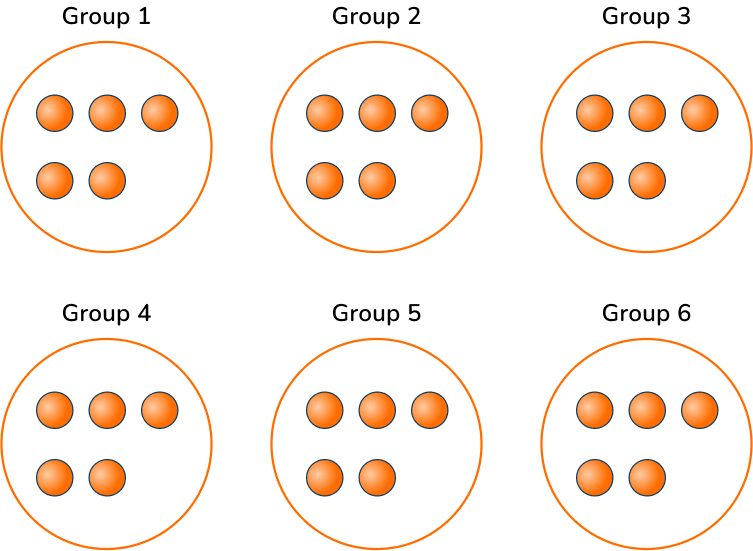

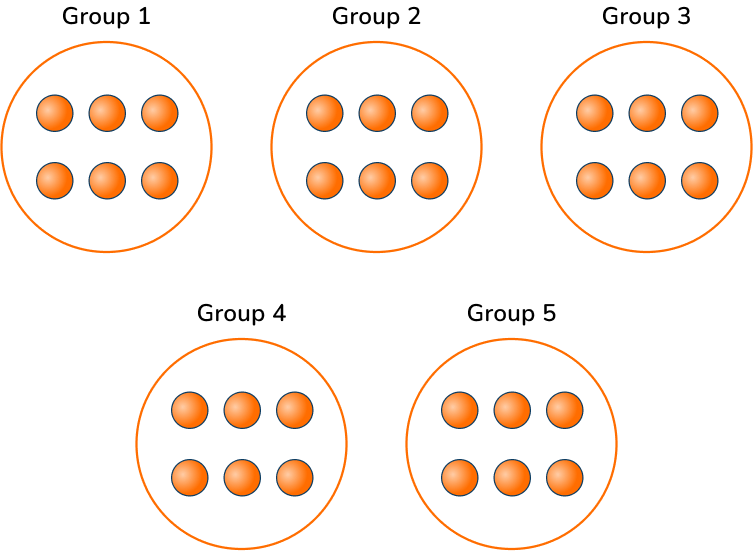

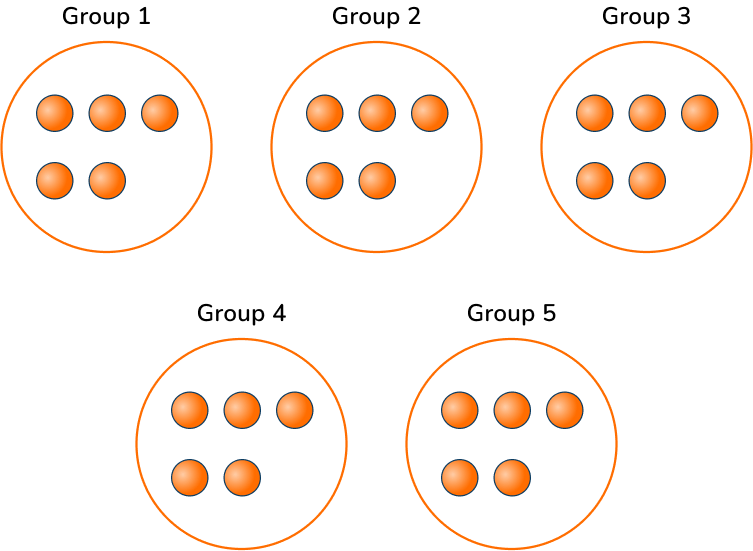

In this word problem, you have a total of 30 objects being divided into 6 groups, so you need to solve 30 \div 6.
The model that shows 6 groups with 5 circles in each group is correct.
2. Solve 1728 \div 27 .




You can find the quotient using long division.

1728 \div 27=64
3. Solve 893 \div 12. Write the remainder as a fraction.




First, use long division to solve. When doing so, you get a remainder of 5. To include the remainder in the quotient as a fraction, you write the remainder as the numerator and the divisor as the denominator.
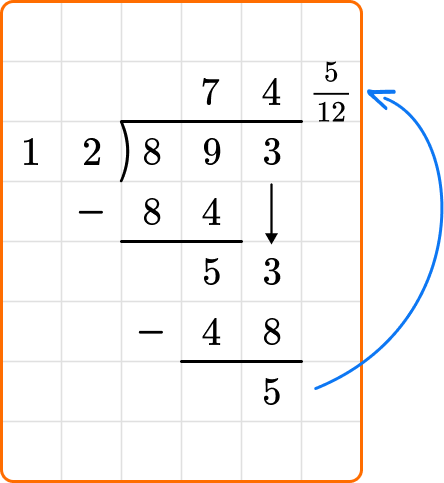
Therefore, 893 \div 12=74 \cfrac{5}{12}
4. Solve 196.2 \div 9 .




This division problem has a decimal, which is the dividend. The divisor is a whole number, however, so you can jump right into the long division process to solve. The decimal point will be placed in the quotient in the same place as the dividend.
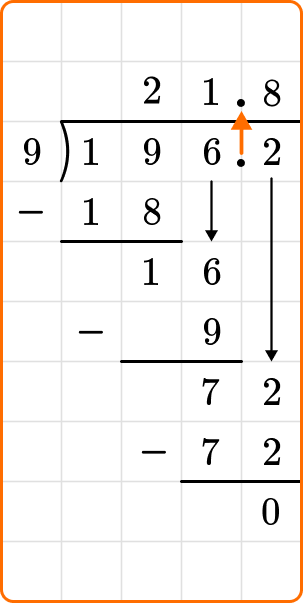
5. Solve 136.92 \div 8.4




Since the divisor is a decimal, first you need to multiply it by a power of 10 to make it a whole number. Since there is one decimal place, you can multiply it by 10 to make it a whole number. Then, you need to multiply the dividend by the same number before beginning the long division process.
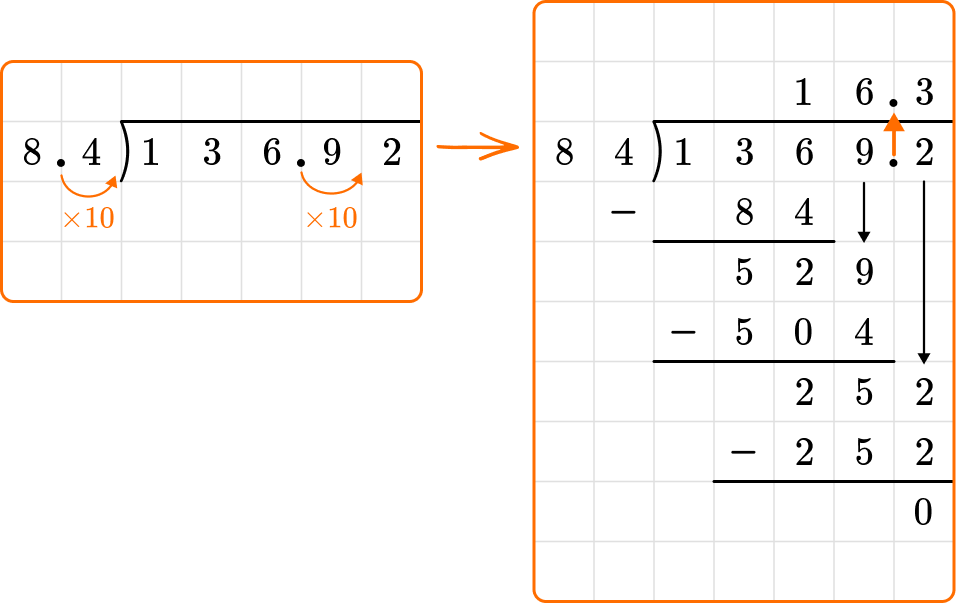
6. Solve 9 \div \cfrac{1}{3} .




To solve, take the reciprocal of the divisor and then change to multiplication.
\begin{aligned}& 9 \div \cfrac{1}{3}= \\\\ & \downarrow \\\\ & 9 \times \cfrac{3}{1}= \\\\ & 9 \times 3=27\end{aligned}
7. Solve \cfrac{3}{8} \div 6. Simplify your answer.




To solve, take the reciprocal of the divisor and then change to multiplication.
\begin{aligned}&\cfrac{3}{8} \div 6=\\\\ & \downarrow \\\\ &\cfrac{3}{8} \times \cfrac{1}{6}=\\\\ &\cfrac{3}{8} \times \cfrac{1}{6}=\cfrac{3}{48}\end{aligned}
\cfrac{3}{48} can be simplified to \cfrac{1}{16}.
Since the directions specify that the answer must be simplified, the correct answer is \cfrac{1}{16}.
8. Solve \cfrac{5}{6} \div \cfrac{2}{3}. Simplify your answer.




To solve, take the reciprocal of the divisor and then change to multiplication.
\begin{aligned}& \cfrac{5}{6} \div \cfrac{2}{3}= \\\\ & \downarrow \\\\ & \frac{5}{6} \times \cfrac{3}{2}= \\\\ & \cfrac{5}{6} \times \cfrac{3}{2}=\cfrac{15}{12}\end{aligned}
\cfrac{15}{12} can be simplified to \cfrac{5}{4} then simplified again to 1 \cfrac{1}{4} \, .
Since the directions specify that the answer must be simplified, the correct answer is 1 \cfrac{1}{4}.
Division FAQs
Division is a mathematical operation that involves splitting a quantity into equal parts or groups, or determining how many times one number (the divisor) is contained within another number (the dividend). The result of division is called the quotient.
Division by zero is “undefined.” This means that it is not possible to divide any number by zero and get a meaningful result.
The division operation is represented by a horizontal line with a dot above and below it called an obelus (\div). It can also be represented by a forward slash (/).
The next lessons are
Still stuck?
At Third Space Learning, we specialize in helping teachers and school leaders to provide personalized math support for more of their students through high-quality, online one-on-one math tutoring delivered by subject experts.
Each week, our tutors support thousands of students who are at risk of not meeting their grade-level expectations, and help accelerate their progress and boost their confidence.

Find out how we can help your students achieve success with our math tutoring programs.
[FREE] Common Core Practice Tests (3rd to 8th Grade)
Prepare for math tests in your state with these 3rd Grade to 8th Grade practice assessments for Common Core and state equivalents.
Get your 6 multiple choice practice tests with detailed answers to support test prep, created by US math teachers for US math teachers!